
Three causes of gearbox failure
In large gear reducers, parts – such as bearings and gears – can be pricey. Understanding gearbox failures can help mitigate downtime.
May 17, 2018 | By Renato Foti
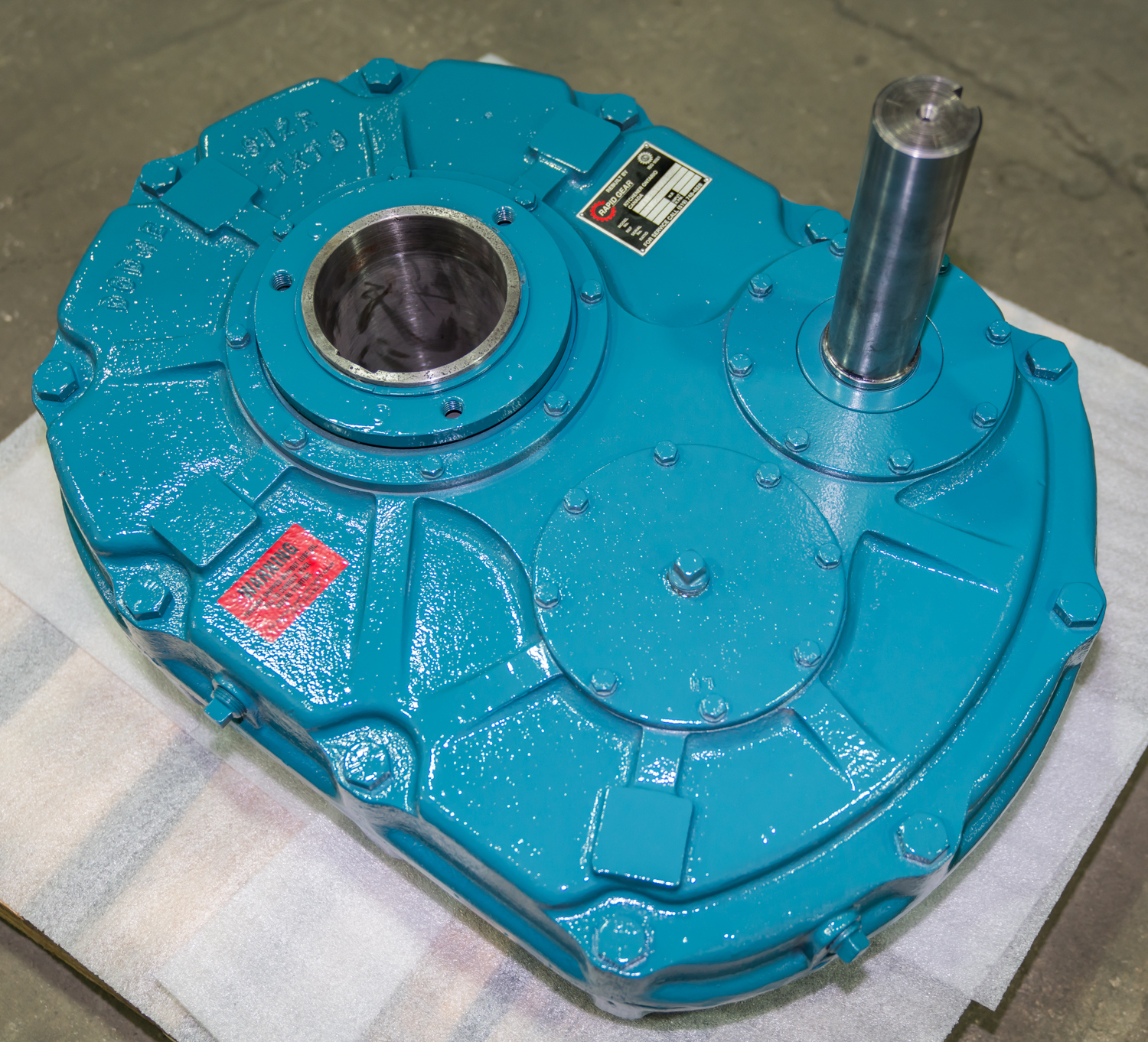
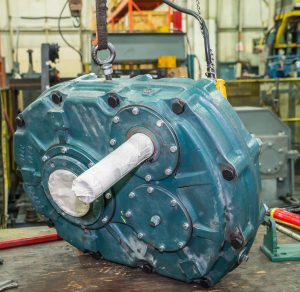
Photo: Rapid Gear.
Gear reducers can be complex machines that apply the science of gearing and mechanical advantage to run thousands of complex operations in many different industries. Gearbox manufacturers have designed a variety of gearboxes in multitudes of different configurations and gear ratios. When failures happen it is critical to understand how to repair the failed units and how to prevent future failures in order to keep production up and running.
Three things that can cause premature failure are poor lubrication, misalignment and overloading. Failure modes can involve bearing failures or gear failures, or both.
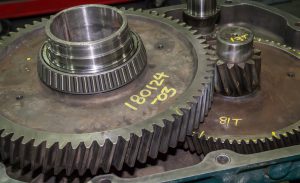 Lubrication
Lubrication
Lubrication is critical for both bearing and gear life. Important aspects of lubrication are the volume of lubricant that is delivered to each gear mesh and bearings, as well as the properties of the lubricant. The lubricant forms a thin film that prevents metal-to-metal contact between gears and between bearing components. Modern industrial gears use an involute tooth form and tooth engagement, which is a combination of rolling and sliding. The oil film is a thin barrier between moving parts that allows the rotating force to turn the gears easily without damage to the metal surfaces. Contamination in the lubricant can result in scuffing and much faster wear for both the bearings and the gearing in a gearbox, so it is imperative that maintenance mechanics check gearbox lubricant for contamination periodically, once for year as a minimum. Each gearbox would have a recommended oil level as well as a method to lubricate both the bearings and the gear set. With bath lubrication, all moving components dip down below the oil level. With splash lubrication, oil is splashed around inside the gearbox housing by fast moving components, covering all moving parts. With pressure lubrication, oil is pumped to each gear mesh and bearing through spray nozzles or oil passages from the gearbox oil sump or from and external reservoir.
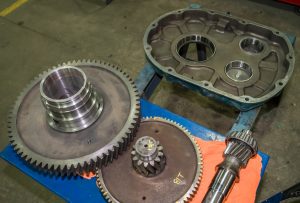 Alignment
Alignment
Gears are designed to mesh with either parallel or right angle shafts and with a specific backlash between gear teeth. The alignment of the gears in the gearbox housing is critical, and assessment of the alignment of the gearbox housing bores is very important when a rebuild is being done. In mining applications, where gear reducers are in heavily loaded applications, we sometimes see firsthand that reducer housings can get distorted or bent. Even a small amount of misalignment can cause premature gear wear and failure. The gear teeth will not mesh the way they were designed to, resulting in excessive loads in the weaker parts of the teeth. Bearings rotating in their bores can also cause wear in the bores, in turn causing misalignment and gear damage.
When receiving a reducer from a mine for rebuild, repair shops should understand all of the application details, including input forces, output requirements, suspected cause of failure, maintenance history, vibration analysis results and oil sample analysis results. Once the reducer is in the shop, a full disassembly will take place with photo documentation and labelling of parts. Gear inspection will include an MPI of the teeth and any wear patterns will be documented. Not all rebuilds will require replacement of gears, in most cases only bearings and seals will be required unless the failure is more catastrophic or if contamination or misalignment has been in place for a longer time. The millwrights will make a full report on every detail so that parts can be ordered or manufactured to complete the rebuild. An engineer will then measure and reverse engineer any gearing so that they can be replaced, if required. Some of the larger and older reducers are no longer available from the original manufacturer, so OEM supply of parts would be impossible. Even if the OEM can supply parts, the lead-time may be prohibitive, especially when an emergency repair is required.
Each reducer is rebuilt after full cleaning, part replacements and housing alignment inspection. Housings can be re-machined if bores are worn or misaligned. The gearbox then has backlash, and bearing clearances measured and documented, and is test run under no load to check for vibration, noise or leakage. Finally, the gearbox is relabelled and painted to look new.
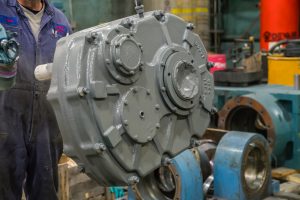 Overload
Overload
We often see reducers that are pushed to the limits and beyond. Conveyers are set to speed up, heavier loads are applied to the outputs and emergency stops and or cold starts can add shock loads to the reducers beyond their design ratings. In older reducers, just the normal wearing of parts can change the internal clearances and cause problems. Once a critical limit is reached, failure can occur quickly.
It can be difficult for mines to know how much extra loading a reducer can take. When a reducer starts to heat up, it draws more power to run, has an increase in noise and vibration levels and time for a rebuild becomes critical. It may take years for the first signs of damage or component failure to appear, but once that initial damage occurs, the progression of damage is accelerated and will ultimately lead to a catastrophic failure. Repairing a gearbox in the initial stages of failure may involve changing only bearings and seals, but repair of a gearbox that has suffered a catastrophic failure will likely involve much more cost as well as a longer lead time.
It is wise for any large facility to have spare bearings, seals or even full gear reducers on site to get back up and running quickly after a failure. If a spare reducer is installed to replace a failed gearbox, the failed reducer can be rebuilt and become the new spare without being rushed, avoiding overtime fees during the repair process. In very large reducers, the parts, such as bearings and gears, can be very expensive, reflecting not just the cost to purchase the components, but also the lead times that cause excessive downtime costs.
Smart monitoring, careful inventory of critical parts and preventative maintenance programs that check the oil temperature, oil contamination and monitor vibration levels will all help minimize downtime. Having a good partnership with a rebuild shop that offers full service and turnkey repairs will also ensure quality rebuilding. As more and more facilities outsource rebuilding services, understanding what suppliers can and can’t do is critical.
Rapid Gear is an OEM supplier of custom gearing and precision machined parts. As part of our MRO services as a full turnkey supplier, Rapid Gear also offers full rebuilding services, including reverse engineering for any make or brand of gear reducer. Renato Foti, director of business development, Rapid Gear, Kitchener, Ont., can be reached @Renato.Foti@rapidgear.com. For more information, visit www.rapidgear.com.
